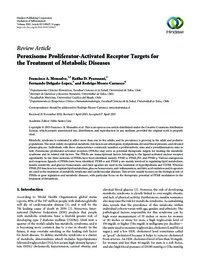Peroxisome proliferator-cctivated receptor targets for the treatment of metabolic diseases
Autor
Monsalve-Abaca, Francisco
Pyarasani, Radha D.
Delgado-López, Fernando
Moore-Carrasco, Rodrigo
Fecha
2013Resumen
Metabolic syndrome is estimated to affect more than one in five adults, and its prevalence is growing in the adult and pediatric
populations. The most widely recognized metabolic risk factors are atherogenic dyslipidemia, elevated blood pressure, and elevated plasma glucose. Individuals with these characteristics commonly manifest a prothrombotic state and a proinflammatory state as well. Peroxisome proliferator-activated receptors (PPARs) may serve as potential therapeutic targets for treating the metabolic syndrome and its related risk factors. The PPARs are transcriptional factors belonging to the ligand-activated nuclear receptor superfamily. So far, three isoforms of PPARs have been identified, namely, PPAR-𝛼, PPAR-𝛽/𝛿, and PPAR-𝛾. Various endogenous and exogenous ligands of PPARs have been identified. PPAR-𝛼 and PPAR-𝛾 are mainly involved in regulating lipid metabolism, insulin sensitivity, and glucose homeostasis, and their agonists are used in the treatment of hyperlipidemia and T2DM. Whereas PPAR-𝛽/𝛿 function is to regulate lipid metabolism, glucose homeostasis, anti-inflammation, and fatty acid oxidation and its agonists are used in the treatment of metabolic syndrome and cardiovascular diseases. This review mainly focuses on the biological role of PPARs in gene regulation and metabolic diseases, with particular focus on the therapeutic potential of PPAR modulators in the treatment of thrombosis.
Fuente
Mediators of Inflammation, 2013, 549627Identificador DOI
dx.doi.org/10.1155/2013/549627Colecciones
La publicación tiene asociados los siguientes ficheros de licencia:


